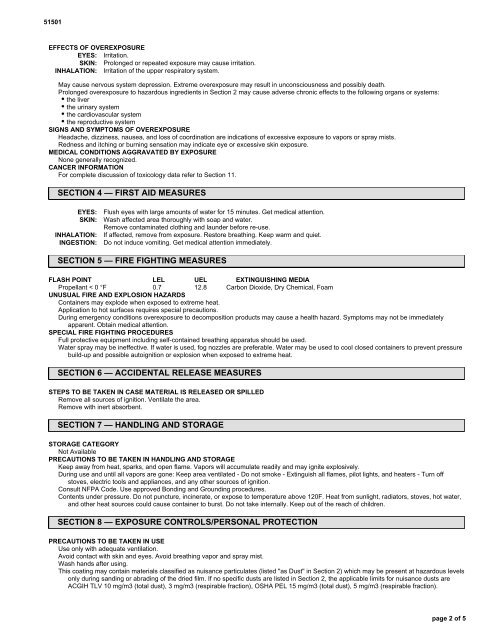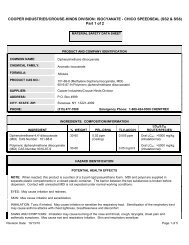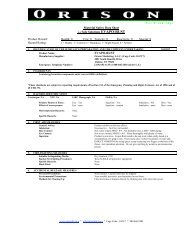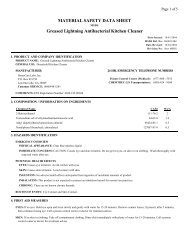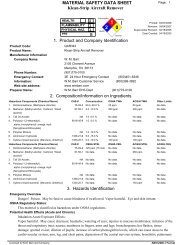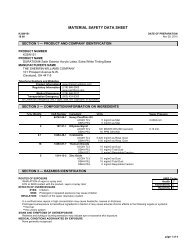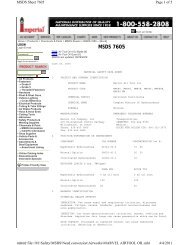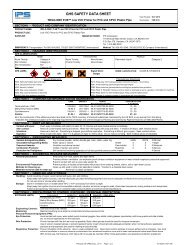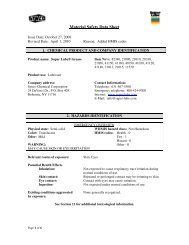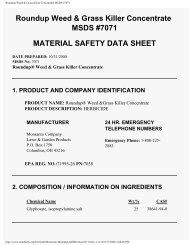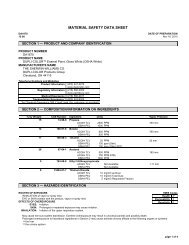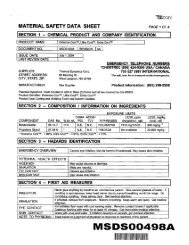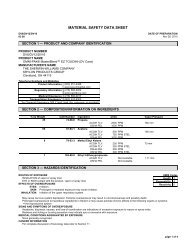sherwin williams krylon indoor outdoor paint gloss white
sherwin williams krylon indoor outdoor paint gloss white
sherwin williams krylon indoor outdoor paint gloss white
You also want an ePaper? Increase the reach of your titles
YUMPU automatically turns print PDFs into web optimized ePapers that Google loves.
51501<br />
EFFECTS OF OVEREXPOSURE<br />
EYES: Irritation.<br />
SKIN: Prolonged or repeated exposure may cause irritation.<br />
INHALATION: Irritation of the upper respiratory system.<br />
May cause nervous system depression. Extreme overexposure may result in unconsciousness and possibly death.<br />
Prolonged overexposure to hazardous ingredients in Section 2 may cause adverse chronic effects to the following organs or systems:<br />
the liver<br />
the urinary system<br />
the cardiovascular system<br />
the reproductive system<br />
SIGNS AND SYMPTOMS OF OVEREXPOSURE<br />
Headache, dizziness, nausea, and loss of coordination are indications of excessive exposure to vapors or spray mists.<br />
Redness and itching or burning sensation may indicate eye or excessive skin exposure.<br />
MEDICAL CONDITIONS AGGRAVATED BY EXPOSURE<br />
None generally recognized.<br />
CANCER INFORMATION<br />
For complete discussion of toxicology data refer to Section 11.<br />
SECTION 4 — FIRST AID MEASURES<br />
EYES:<br />
SKIN:<br />
INHALATION:<br />
INGESTION:<br />
Flush eyes with large amounts of water for 15 minutes. Get medical attention.<br />
Wash affected area thoroughly with soap and water.<br />
Remove contaminated clothing and launder before re-use.<br />
If affected, remove from exposure. Restore breathing. Keep warm and quiet.<br />
Do not induce vomiting. Get medical attention immediately.<br />
SECTION 5 — FIRE FIGHTING MEASURES<br />
FLASH POINT<br />
LEL UEL EXTINGUISHING MEDIA<br />
Propellant < 0 °F<br />
0.7<br />
12.8 Carbon Dioxide, Dry Chemical, Foam<br />
UNUSUAL FIRE AND EXPLOSION HAZARDS<br />
Containers may explode when exposed to extreme heat.<br />
Application to hot surfaces requires special precautions.<br />
During emergency conditions overexposure to decomposition products may cause a health hazard. Symptoms may not be immediately<br />
apparent. Obtain medical attention.<br />
SPECIAL FIRE FIGHTING PROCEDURES<br />
Full protective equipment including self-contained breathing apparatus should be used.<br />
Water spray may be ineffective. If water is used, fog nozzles are preferable. Water may be used to cool closed containers to prevent pressure<br />
build-up and possible autoignition or explosion when exposed to extreme heat.<br />
SECTION 6 — ACCIDENTAL RELEASE MEASURES<br />
STEPS TO BE TAKEN IN CASE MATERIAL IS RELEASED OR SPILLED<br />
Remove all sources of ignition. Ventilate the area.<br />
Remove with inert absorbent.<br />
SECTION 7 — HANDLING AND STORAGE<br />
STORAGE CATEGORY<br />
Not Available<br />
PRECAUTIONS TO BE TAKEN IN HANDLING AND STORAGE<br />
Keep away from heat, sparks, and open flame. Vapors will accumulate readily and may ignite explosively.<br />
During use and until all vapors are gone: Keep area ventilated - Do not smoke - Extinguish all flames, pilot lights, and heaters - Turn off<br />
stoves, electric tools and appliances, and any other sources of ignition.<br />
Consult NFPA Code. Use approved Bonding and Grounding procedures.<br />
Contents under pressure. Do not puncture, incinerate, or expose to temperature above 120F. Heat from sunlight, radiators, stoves, hot water,<br />
and other heat sources could cause container to burst. Do not take internally. Keep out of the reach of children.<br />
SECTION 8 — EXPOSURE CONTROLS/PERSONAL PROTECTION<br />
PRECAUTIONS TO BE TAKEN IN USE<br />
Use only with adequate ventilation.<br />
Avoid contact with skin and eyes. Avoid breathing vapor and spray mist.<br />
Wash hands after using.<br />
This coating may contain materials classified as nuisance particulates (listed "as Dust" in Section 2) which may be present at hazardous levels<br />
only during sanding or abrading of the dried film. If no specific dusts are listed in Section 2, the applicable limits for nuisance dusts are<br />
ACGIH TLV 10 mg/m3 (total dust), 3 mg/m3 (respirable fraction), OSHA PEL 15 mg/m3 (total dust), 5 mg/m3 (respirable fraction).<br />
page 2 of 5


